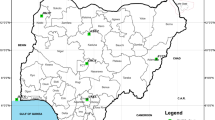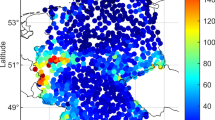Abstract
Reanalysis products have played an important role in space geodetic tropospheric delay retrieval and modeling in the past two decades. As the release of the fifth-generation European Centre for Medium-Range Weather Forecasts (ECMWF) Re-Analysis (ERA5), with improved temporal-spatial resolutions compared to its predecessor, ECMWF Re-Analysis Interim (ERAI), the performance of ERA5 in tropospheric delay retrieval was comprehensively investigated in this study. Hourly tropospheric delays in zenith and 5° elevation directions at 312 International GNSS Service (IGS) stations covering the year of 2018 from ERA5 and ERAI were ray-traced. Taking IGS Zenith Total Delay (ZTD) as reference, the reanalysis-derived ZTDs were evaluated in annual, seasonal and diurnal scales, and superior performances of ERA5 ZTD to ERAI ZTD in all scales were revealed, with bias, Root Mean Square (RMS) and standard deviation of 1.6, 11.0 and 10.1 mm for ERA5, and of 3.1, 13.8 and 12.6 mm for ERAI, respectively. Due to the absence of reliable Slant Path Delay (SPD) references, the SPDs as well as the mapping factors derived from ERA5 and ERAI were directly compared and converted to equivalent station height errors at these stations. Obvious differences were also found for SPDs and mapping factors, especially for the wet component, with slant wet delay and wet mapping factor difference RMSs of 51.9 mm and 146.1 × 10−3, respectively, corresponding to equivalent station height RMSs of about 10.4 mm. Tropospheric delays and models (e.g., mapping functions) derived from ERA5, with improved performance and temporal resolution (e.g., to support potential tropospheric parameter diurnal variation study), therefore can be expected for space geodetic applications.











Similar content being viewed by others
Data availability
IGS and CODE ZTD products were available through IGS FTP (cddis.gsfc.nasa.gov/) and CODE FTP (ftp.aiub.unibe.ch/). ERA5 and ERAI were downloaded from Copernicus Climate Data Store (https://cds.climate.copernicus.eu/) and ECMWF (https://www.ecmwf.int/), respectively.
References
Alshawaf F, Zus F, Balidakis K, Deng Z, Hoseini M, Dick G, Wickert J (2018) On the statistical significance of climatic trends estimated from GPS tropospheric time series. J Geophys Res Atmos 123(19):10–967. https://doi.org/10.1029/2018JD02870
Böhm J (2004) Troposphärische Laufzeitverzögerungen in der VLBI. Doctoral Dissertation, Institut für Geodäsie und Geophysik, TU Wien, Supervisor, Schuh H. https://publik.tuwien.ac.at/files/PubDat_119666.pdf
Böhm J, Schuh H (2004) Vienna mapping functions in VLBI analyses. Geophys Res Lett. https://doi.org/10.1029/2003GL018984
Böhm J, Schuh H (2007) Troposphere gradients from the ECMWF in VLBI analysis. J Geod 81(6–8):403–408. https://doi.org/10.1007/s00190-007-0144-2
Böhm J, Niell A, Tregoning P, Schuh H (2006a) Global mapping function (GMF): a new empirical mapping function based on numerical weather model data. Geophys Res Lett. https://doi.org/10.1029/2005GL025546
Böhm J, Werl B, Schuh H (2006b) Troposphere mapping functions for GPS and very long baseline interferometry from European Centre for Medium-Range Weather Forecasts operational analysis data. J Geophys Res Solid Earth 111:2. https://doi.org/10.1029/2005JB003629
Böhm J, Kouba J, Schuh H (2009) Forecast Vienna Mapping Functions 1 for real-time analysis of space geodetic observations. J Geod 83(5):397–401. https://doi.org/10.1007/s00190-008-0216-y
Böhm J, Möller G, Schindelegger M, Pain G, Weber R (2015) Development of an improved empirical model for slant delays in the troposphere (GPT2w). GPS Solut 19(3):433–441. https://doi.org/10.1007/s10291-014-0403-7
Boisits J, Landskron D, Sosnica K, Drozdzewski M, Böhm J (2018) VMF3o enhanced tropospheric mapping functions for optical frequencies. Presented at:21 st international workshop on laser ranging, Canberra. https://cddis.nasa.gov/lw21/docs/2018/papers/Session2_Boisits_paper.pdf
Born M, Wolf E (1999) Principles of optics, electromagnetic theory of propagation, interference and diffraction of light, 7th edn. Cambridge University Press, Cambridge. ISBN 978-0-521-64222-4
Brunamonti S, Füzér L, Jorge T, Poltera Y, Oelsner P, Meier S, Wienhold FG (2019) Water vapor in the Asian summer monsoon anticyclone: comparison of balloon-borne measurements and ECMWF data. J Geophys Res Atmos 124(13):7053–7068. https://doi.org/10.1029/2018JD030000
Byun SH, Bar-Sever YE (2009) A new type of troposphere zenith path delay product of the international GNSS service. J Geod 83(3–4):367–373. https://doi.org/10.1007/s00190-008-0288-8
Drożdżewski M, Sośnica K, Zus F, Balidakis K (2019) Troposphere delay modeling with horizontal gradients for satellite laser ranging. J Geod 93(10):1853–1866. https://doi.org/10.1007/s00190-019-01287-1
Graham RM, Hudson SR, Maturilli M (2019) Improved performance of ERA5 in Arctic gateway relative to four global atmospheric reanalyses. Geophys Res Lett 46(11):6138–6147. https://doi.org/10.1029/2019GL082781
Hersbach H, Bell B, Berrisford P, Horányi A, Sabater JM, Nicolas J, Dee D (2019) Global reanalysis: goodbye ERA-Interim, hello ERA5. ECMWF Newslett 159:17–24
Hobiger T, Ichikawa R, Koyama Y, Kondo T (2008a) Fast and accurate ray-tracing algorithms for real-time space geodetic applications using numerical weather models. J Geophys Res Atmos 113:D20. https://doi.org/10.1029/2008JD010503
Hobiger T, Ichikawa R, Takasu T, Koyama Y, Kondo T (2008b) Ray-traced troposphere slant delays for precise point positioning. Earth Planets Space 60:e1–e4. https://doi.org/10.1186/BF03352809
Hobiger T, Kinoshita Y, Shimizu S, Ichikawa R, Furuya M, Kondo T, Koyama Y (2010) On the importance of accurately ray-traced troposphere corrections for Interferometric SAR data. J Geod 84(9):537–546. https://doi.org/10.1007/s00190-010-0393-3
Hoffmann L, Günther G, Li D, Stein O, Wu X, Griessbach S, Wright JS (2019) From ERA-Interim to ERA5: the considerable impact of ECMWF’s next-generation reanalysis on Lagrangian transport simulations. Atmos Chem Phys 19:3097–3124. https://doi.org/10.5194/acp-19-3097-2019
Hofmeister A (2016) Determination of path delays in the atmosphere for geodetic VLBI by means of ray-tracing. Doctoral Dissertation, Department of Geodesy and Geoinformation, TU Wien, Supervisor: Böhm J. http://resolver.obvsg.at/urn:nbn:at:at-ubtuw:1-3444
Hofmeister A, Böhm J (2017) Application of ray-traced tropospheric slant delays to geodetic VLBI analysis. J Geod 91(8):945–964. https://doi.org/10.1007/s00190-017-1000-7
Jiang C, Xu T, Wang S, Nie W, Sun Z (2020) Evaluation of zenith tropospheric delay derived from ERA5 data over China using GNSS observations. Remote Sens 12(4):663. https://doi.org/10.3390/rs12040663
Kållberg PW, Simmons A, Uppala S, Fuentes M (2004) ERA-40 project report series ERA Report. Shinfield Park Read 17:1–31
Kinoshita Y, Shimada M, Furuya M (2013) InSAR observation and numerical modeling of the water vapor signal during a heavy rain: a case study of the 2008 Seino event, central Japan. Geophys Res Lett 40(17):4740–4744. https://doi.org/10.1002/grl.50891
Lagler K, Schindelegger M, Böhm J, Krásná H, Nilsson T (2013) GPT2: empirical slant delay model for radio space geodetic techniques. Geophys Res Lett 40(6):1069–1073. https://doi.org/10.1002/grl.50288
Landskron D (2017) Modeling tropospheric delays for space geodetic techniques. Doctoral Dissertation, Department of Geodesy and Geoinformation, TU Wien, Supervisor: Böhm J. http://repositum.tuwien.ac.at/obvutwhs/content/titleinfo/2099559
Landskron D, Böhm J (2018a) Refined discrete and empirical horizontal gradients in VLBI analysis. J Geod 92(12):1387–1399. https://doi.org/10.1007/s00190-018-1127-1
Landskron D, Böhm J (2018b) VMF3/GPT3: refined discrete and empirical troposphere mapping functions. J Geod 92(4):349–360. https://doi.org/10.1007/s00190-017-1066-2
MacMillan DS, Ma C (1994) Evaluation of very long baseline interferometry atmospheric modeling improvements. J Geophys Res Solid Earth 99(B1):637–651. https://doi.org/10.1029/93JB02162
Mendes VB, Prates G, Pavlis EC, Pavlis DE, Langley RB (2002) Improved mapping functions for atmospheric refraction correction in SLR. Geophys Res Lett 29(10):53-1–53-4. https://doi.org/10.1029/2001GL014394
Nafisi V, Urquhart L, Santos MC, Nievinski FG, Bohm J, Wijaya DD, Zus F (2011) Comparison of ray-tracing packages for troposphere delays. IEEE Trans Geosci Remote Sens 50(2):469–481. https://doi.org/10.1109/TGRS.2011.2160952
Niell AE (1996) Global mapping functions for the atmosphere delay at radio wavelengths. J Geophys Res Solid Earth 101(B2):3227–3246. https://doi.org/10.1029/95JB03048
Nievinski FG (2009) Ray-tracing options to mitigate the neutral atmosphere delay in GPS. Master Dissertation, Department of Geodesy and Geomatics Engineering, University of New Brunswick, Supervisor: Santos MC. https://www.researchgate.net/publication/41036785
Nikolaidou T, Balidakis K, Nievinski FG, Santos MC, Schuh H (2018) Impact of different NWM-derived mapping functions on VLBI and GPS analysis. Earth Planets Space 70(1):1–16. https://doi.org/10.1186/s40623-018-0865-x
Nilsson T, Böhm J, Wijaya DD, Tresch A, NafisiV SH (2013) Path delays in the neutral atmosphere. In: Böhm J, Schuh H (eds) Atmospheric effects in space geodesy. Springer atmospheric sciences. Springer, Berlin, pp 73–136. https://doi.org/10.1007/978-3-642-36932-2_3. ISBN 978-3-642-36931-5
Pacione R, Araszkiewicz A, Brockmann E, Dousa J (2017) EPN-Repro2: a reference GNSS tropospheric data set over Europe. Atmos Meas Tech 10(5):1689–1705. https://doi.org/10.5194/amt-10-1689-2017
Rocken C, Sokolovskiy S, Johnson JM, Hunt D (2001) Improved mapping of tropospheric delays. J Atmos Oceanic Technol 18(7):1205–1213. https://doi.org/10.1175/1520-0426(2001)018%3c1205:IMOTD%3e2.0.CO;2
Rüeger JM (2002) Refractive index formulae for radio waves. In: Proceedings of the FIG XXII international congress, FIG, Washington, D.C., USA. https://www.fig.net/resources/proceedings/fig_proceedings/fig_2002/Js28/JS28_rueger.pdf
Santos MC, McAdam MP, Böhm J (2012) Implementation Status of the UNB-VMF1. Geophysical Research Abstracts, European Geosciences Union General Assembly (EGU 2012), 22-27 April, Vienna, Vol 14, EGU2012-13759. http://unb-vmf1.gge.unb.ca/publications/EGU2012-poster-UNB-VMF1.pdf
Smith EK, Weintraub S (1953) The constants in the equation for atmospheric refractive index at radio frequencies. Proc IRE 41(8):1035–1037. https://doi.org/10.1109/JRPROC.1953.274297
Urquhart L, Nievinski FG, Santos MC (2012) Ray-traced slant factors for mitigating the tropospheric delay at the observation level. J Geod 86(2):149–160. https://doi.org/10.1007/s00190-011-0503-x
Urquhart L, Nievinski FG, Santos MC (2014) Assessment of troposphere mapping functions using three-dimensional ray-tracing. GPS Solut 18(3):345–354. https://doi.org/10.1007/s10291-013-0334-8
Wallace JM, Hobbs PV (2006) Atmospheric Thermodynamics. In: Atmospheric science: an introductory survey. 2nd ed. Academic Press. Chap. 3, pp 63–111. ISBN: 978-0-12-732951-2. https://doi.org/10.1016/B978-0-12-732951-2.50008-9
Zhang W, Zhang H, Liang H, Lou Y, Cai Y, Cao Y, Liu W (2019a) On the suitability of ERA5 in hourly GPS precipitable water vapor retrieval over China. J Geod 93(10):1897–1909. https://doi.org/10.1007/s00190-019-01290-6
Zhang Y, Cai C, Chen B, Dai W (2019b) Consistency evaluation of precipitable water vapor derived from ERA5, ERA-Interim, GNSS, and radiosondes over China. Radio Sci 54(7):561–571. https://doi.org/10.1029/2018RS006789
Zus F, Dick G, Douša J, Heise S, Wickert J (2014) The rapid and precise computation of GPS slant total delays and mapping factors utilizing a numerical weather model. Radio Sci 49(3):207–216. https://doi.org/10.1002/2013RS005280
Zus F, Dick G, Douša J, Wickert J (2015) Systematic errors of mapping functions which are based on the VMF1 concept. GPS Solut 19:277–286. https://doi.org/10.1007/s10291-014-0386-4
Acknowledgements
This work was supported by the National Natural Science Foundation of China (41774036; 41804023; 41961144015), the Fundamental Research Funds for the Central Universities (2042020kf0020), the China Postdoctoral Science Foundation funded Project (2017M622518), and the Natural Science Foundation of Hubei Province of China (2018CFB193). Authors would like to thank IGS, CODE, Copernicus Climate Data Store and ECMWF for providing the research datasets, and acknowledge Higher Geodesy team of Technische Universität Wien for developing the open-source ray-tracing package RADIATE. Authors also would like to appreciate Supercomputing Center of Wuhan University for the global tropospheric delay ray-tracing calculations from 0.25° ERA5 products.
Author information
Authors and Affiliations
Contributions
YDL and WXZ proposed the initial ideas. YZZ and WXZ designed and performed the specific experiments, as well as wrote the manuscript with support from YDL. CLK, WXL and JNB participated in the experiments, and also provided some helpful suggestions for shaping the research, analysis and manuscript.
Corresponding authors
Rights and permissions
About this article
Cite this article
Zhou, Y., Lou, Y., Zhang, W. et al. Improved performance of ERA5 in global tropospheric delay retrieval. J Geod 94, 103 (2020). https://doi.org/10.1007/s00190-020-01422-3
Received:
Accepted:
Published:
DOI: https://doi.org/10.1007/s00190-020-01422-3




